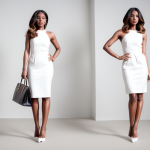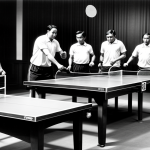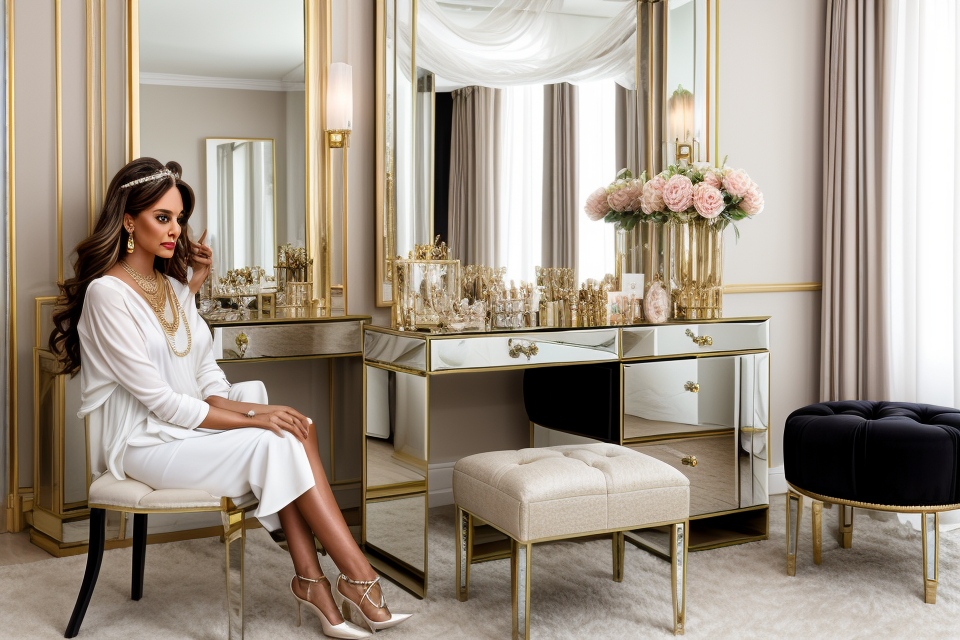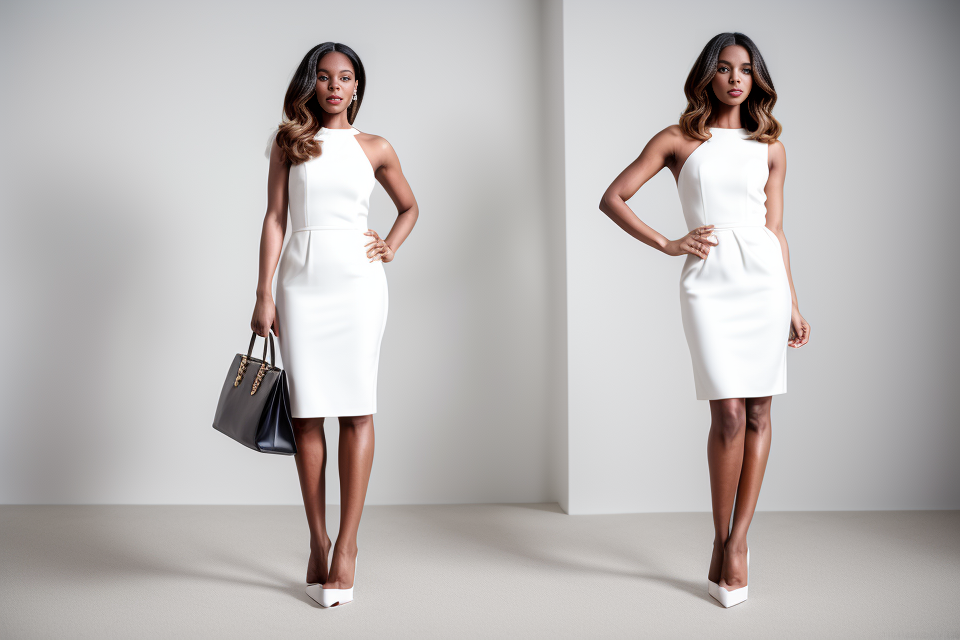Why do humans wear accessories? It’s a question that has puzzled us for centuries. From the earliest of times, humans have adorned themselves with various items, from flowers to jewelry, to express their individuality and communicate with others. But why do we feel the need to accessorize in the first place? What is it about these small, seemingly insignificant items that can have such a profound impact on our lives? In this article, we’ll delve into the psychology of wearing accessories and explore the many reasons why humans have always been drawn to adorning themselves.
The Evolution of Accessories in Human Culture
The Symbolic Significance of Jewelry and Accessories Throughout History
- Jewelry and accessories have held symbolic significance throughout human history, serving as expressions of personal identity, social status, and cultural values.
- Ancient civilizations used jewelry and accessories to signify wealth, power, and religious beliefs. For example, in ancient Egypt, pharaohs and other wealthy individuals were buried with elaborate jewelry, which was believed to protect them in the afterlife.
- In medieval Europe, nobles and royals adorned themselves with lavish jewels and accessories to display their wealth and social status. This practice was also a way to show allegiance to their respective kingdoms and religions.
- During the Victorian era, jewelry and accessories became a means of expressing emotions and sentiments. For instance, the wearing of mourning jewelry, which included pieces made from the hair of deceased loved ones, was a way to remember and honor the dead.
- In the early 20th century, the Art Deco movement saw the creation of bold and ornate jewelry and accessories that reflected the glamour and extravagance of the time. These pieces were often crafted from expensive materials like diamonds, rubies, and sapphires, and were worn to showcase wealth and fashionable taste.
- In modern times, jewelry and accessories continue to hold symbolic significance, but their meanings have become more nuanced and individualized. For example, a person may choose to wear a certain type of necklace or bracelet to express their personal style or to make a political statement.
- Overall, the symbolic significance of jewelry and accessories throughout history reflects the complex interplay between personal expression, social status, and cultural values.
The Role of Accessories in Self-Expression and Communication
Accessories have played a significant role in human culture since the dawn of civilization. From the earliest days of human history, individuals have used accessories to communicate their social status, personal beliefs, and cultural identity.
In ancient times, accessories were often used as symbols of power and wealth. For example, in ancient Egypt, rulers were known to adorn themselves with elaborate jewelry and ornate headdresses made of precious metals and gemstones. These accessories served as a visible display of their wealth and authority, as well as a means of communicating their divine status.
Today, accessories continue to play a crucial role in self-expression and communication. They allow individuals to convey their personal style, tastes, and preferences to others. Accessories can also be used to make a statement or to express one’s beliefs or values. For instance, a person may choose to wear a necklace or bracelet made from recycled materials to show their support for environmental causes.
Furthermore, accessories can also be used to project a certain image or persona. For example, a person may wear a suit and tie to a job interview to project a professional image, or they may wear a leather jacket and sunglasses to project a more rebellious, edgy image.
In summary, accessories have always been an important tool for self-expression and communication. From ancient times to the present day, they have allowed individuals to convey their personal style, beliefs, and cultural identity to others.
The Psychological Benefits of Wearing Accessories
Enhancing Self-Confidence and Self-Esteem
Wearing accessories can have a profound impact on an individual’s psychological well-being, particularly in terms of enhancing self-confidence and self-esteem. In this section, we will delve into the various ways in which accessories can influence these aspects of an individual’s mental health.
Boosting Social Presence
One of the primary ways in which accessories can enhance self-confidence and self-esteem is by boosting an individual’s social presence. When an individual wears accessories that align with their personal style and identity, they may feel more confident and self-assured in social situations. This confidence can translate into greater social presence, as individuals are more likely to feel comfortable and assertive in social settings.
Personal Expression
Accessories also provide an opportunity for individuals to express their personal style and identity, which can boost self-confidence and self-esteem. When individuals wear accessories that reflect their unique personalities and tastes, they may feel more authentic and true to themselves. This personal expression can foster a sense of self-acceptance and self-appreciation, which can have a positive impact on overall self-esteem.
Social Recognition
Wearing accessories can also lead to social recognition and validation, which can enhance self-confidence and self-esteem. When individuals receive positive feedback or compliments on their accessories, it can reinforce their sense of self-worth and confidence. This social recognition can also provide a boost to an individual’s social status or reputation, further enhancing their self-confidence and self-esteem.
Emotional Regulation
Finally, wearing accessories can also serve as a means of emotional regulation, which can have a positive impact on self-confidence and self-esteem. When individuals wear accessories that evoke positive emotions or memories, it can serve as a source of comfort and stability. Additionally, wearing accessories that reflect current moods or emotions can provide a means of emotional expression and release, which can enhance overall self-confidence and self-esteem.
Overall, wearing accessories can have a significant impact on an individual’s self-confidence and self-esteem. By providing opportunities for personal expression, boosting social presence, offering social recognition, and serving as a means of emotional regulation, accessories can have a positive influence on an individual’s mental health and well-being.
Creating a Sense of Identity and Individuality
Wearing accessories can be an effective way to express one’s identity and individuality. Accessories allow individuals to make a statement about their personal style and values, and can serve as a form of self-expression. In this section, we will explore the psychological benefits of wearing accessories and how they can contribute to a sense of identity and individuality.
- Personal Style: Wearing accessories can help individuals express their personal style and individuality. Accessories can be used to accentuate one’s features, complement one’s outfit, or make a bold statement. By wearing accessories that reflect their personal style, individuals can feel more confident and comfortable in their own skin.
- Self-Expression: Accessories can also serve as a form of self-expression. By wearing accessories that reflect their interests, values, and personality, individuals can communicate their unique identity to others. For example, a person who values environmental sustainability may choose to wear a necklace made from recycled materials, or a person who is passionate about music may choose to wear a pair of earrings in the shape of a guitar.
- Social Signaling: Wearing accessories can also be a way to signal one’s social identity and group affiliations. For example, a person may choose to wear a hat or t-shirt with a logo or slogan that reflects their political beliefs or sports team loyalty. This can help individuals connect with others who share similar interests and values, and can strengthen their sense of belonging to a particular group.
- Positive Feedback: Finally, wearing accessories can provide positive feedback and reinforcement. When individuals receive compliments or positive comments about their accessories, it can boost their confidence and self-esteem. This can be especially important for individuals who may feel marginalized or underrepresented in their social circles, as it can provide a sense of validation and recognition.
Overall, wearing accessories can be a powerful tool for creating a sense of identity and individuality. By expressing their personal style, values, and social affiliations through their accessories, individuals can feel more confident, connected, and valued.
Expressing Emotions and Moods
Wearing accessories can be an effective way to express one’s emotions and moods. By selecting certain items, individuals can convey their current state of mind or intentions to others. For example, wearing a black leather jacket may suggest a rebellious or edgy attitude, while a delicate silver necklace could convey a more refined or elegant mood.
Furthermore, the color of an accessory can also play a significant role in conveying emotions. Red, for instance, is often associated with passion and energy, while blue is commonly linked to calmness and serenity. Thus, wearing a red scarf may indicate a lively and enthusiastic personality, while a blue bracelet could suggest a more tranquil and introspective individual.
Additionally, certain accessories can have specific cultural or social meanings. For example, wearing a wedding ring may symbolize commitment and partnership, while a cross necklace could represent religious beliefs. Thus, the choice of accessory can also communicate one’s cultural background or affiliations.
Overall, wearing accessories can be a powerful tool for expressing one’s emotions and moods, and can also communicate important aspects of an individual’s identity.
The Impact of Accessories on Social Interactions
The Role of Accessories in Nonverbal Communication
Wearing accessories not only adds a touch of style to one’s appearance but also plays a significant role in nonverbal communication. Accessories, such as jewelry, hats, scarves, and bags, can convey various messages to others, intentionally or unintentionally. Here’s a closer look at the role of accessories in nonverbal communication:
Signaling Social Status
Accessories can be used to signal one’s social status, conveying a message about one’s wealth, occupation, or social standing. For example, a designer handbag or a diamond necklace may indicate that the wearer has a higher socioeconomic status. In some cases, wearing certain accessories may even suggest affiliation with a particular social group or subculture.
Expressing Emotions
Accessories can also be used to express emotions or moods. For instance, wearing a black bandana as a headband or a black armband may signal sadness or mourning. On the other hand, wearing a bright, colorful scarf or a large, bold necklace may suggest happiness or confidence. The use of accessories can also be culturally specific, with certain traditions or customs dictating the types of accessories worn to express certain emotions.
Conveying Personality Traits
Accessories can also reveal certain personality traits of the wearer. For example, wearing a large, bold watch may suggest a preference for material possessions or a practical, no-nonsense approach to life. Wearing a delicate, dainty necklace may suggest a more feminine or artistic side. These subtle cues can help others form first impressions of a person’s personality.
Establishing Connection
Finally, accessories can also be used to establish a connection with others. For example, wearing a bracelet with a charm that signifies a shared interest or hobby can help break the ice and start a conversation with a stranger. Wearing a hat or sunglasses with a logo or brand name can also indicate affiliation with a particular group or team, fostering a sense of community and belonging.
In conclusion, accessories play a crucial role in nonverbal communication, conveying various messages about the wearer’s social status, emotions, personality, and affiliations. By understanding the power of accessories in nonverbal communication, one can make more intentional choices about the accessories they wear and how they wish to present themselves to others.
The Influence of Accessories on Perception and First Impressions
When it comes to social interactions, the role of accessories cannot be overstated. These small, often inconspicuous additions to one’s attire can have a profound impact on how others perceive us. From a psychological standpoint, our brain processes visual information much more quickly than text or sound, meaning that the way we present ourselves visually can greatly influence our first impressions.
- Visual Processing: The human brain is wired to process visual information more quickly and efficiently than any other type of sensory input. This means that the way we present ourselves visually can have a significant impact on how others perceive us.
- First Impressions: Our first impressions of others are often based on their appearance, and this is especially true when it comes to accessories. Research has shown that the way we dress and accessorize can convey a wide range of information about our personality, social status, and even our intelligence.
- Nonverbal Communication: Accessories are a form of nonverbal communication, and they can convey a lot of information about us without saying a word. For example, a person who wears a lot of jewelry may be perceived as flashy or extravagant, while someone who prefers more minimalist accessories may be seen as more understated or sophisticated.
- Personal Style: Personal style is an important factor in how we present ourselves to the world, and accessories play a crucial role in this. Our personal style is a reflection of our individuality and can convey a lot of information about our values, interests, and even our mood.
- Self-expression: Accessories also provide a way for us to express ourselves and convey our unique personality to others. For example, someone who wears a lot of bright, bold jewelry may be expressing their outgoing, confident personality, while someone who prefers more subtle, understated accessories may be expressing a more reserved, introspective personality.
In conclusion, the influence of accessories on perception and first impressions cannot be ignored. They play a crucial role in how we present ourselves to the world and can greatly impact how others perceive us.
The Connection Between Accessories and Social Status
Accessories have long been used as a means of displaying one’s social status. Throughout history, individuals have worn accessories to signal their wealth, power, and social standing. Even today, the types of accessories one wears can provide insight into their social status.
- Fine Jewelry: The wearing of expensive, fine jewelry is often associated with individuals of high social status. Diamonds, in particular, have become a symbol of wealth and power, and are often used to signify a person’s social standing.
- Designer Brands: The wearing of designer brands is another way that individuals can signal their social status. Designer clothing and accessories are often associated with wealth and exclusivity, and can be used to demonstrate one’s status.
- Unusual Accessories: Unusual or unique accessories, such as intricately designed handbags or one-of-a-kind necklaces, can also be used to signal social status. These types of accessories are often associated with creativity and individuality, and can be used to showcase one’s unique style and sense of fashion.
However, it’s important to note that the connection between accessories and social status is not always straightforward. In some cases, individuals may wear accessories as a way of rebelling against societal expectations or as a means of expressing their own personal style, regardless of their social status.
The Cultural Significance of Accessories
The Influence of Cultural Norms and Values on Accessory Choices
The choices we make when it comes to accessorizing our attire are deeply rooted in the cultural norms and values of our society. These norms and values can influence our decisions in ways that may not be immediately apparent.
For example, in some cultures, certain types of jewelry or accessories may be considered more appropriate or inappropriate depending on the occasion or context. In formal settings, such as a wedding or a business meeting, wearing bold or flashy accessories may be seen as inappropriate or disrespectful. On the other hand, in casual settings, such as a beach or a music festival, wearing more relaxed and comfortable accessories may be preferred.
Additionally, cultural norms and values can also influence the materials and designs of accessories. For instance, in some cultures, certain materials, such as gold or silver, may be seen as more valuable or prestigious than others, such as plastic or synthetic materials. Similarly, certain designs or styles may be more or less popular depending on cultural trends and preferences.
It is also important to consider the role of gender in accessory choices. In some cultures, there may be specific expectations or norms surrounding the types of accessories that men and women should wear. For example, in some cultures, men may be expected to wear more traditional or conservative accessories, such as a tie or a hat, while women may have more freedom to experiment with different styles and designs.
Overall, the influence of cultural norms and values on accessory choices cannot be overstated. By understanding these influences, we can gain a deeper appreciation for the ways in which our accessory choices reflect and shape our cultural identity.
The Role of Accessories in Rituals and Traditions
In many cultures, accessories hold a significant place in rituals and traditions. From weddings to religious ceremonies, accessories are often used to signify important moments or to symbolize certain values or beliefs.
For example, in some cultures, the wearing of certain accessories, such as a wedding ring or a cross necklace, is seen as a symbol of commitment or faith. In other cultures, accessories may be used to indicate social status or to mark a person’s membership in a particular group or community.
Moreover, accessories can also play a role in cultural traditions related to mourning or remembrance. For instance, in some cultures, it is customary to wear black or white accessories as a sign of mourning, while in others, it is common to wear a particular type of headpiece or pin to commemorate a loved one who has passed away.
Overall, the role of accessories in rituals and traditions highlights their importance as symbolic objects that can hold deep cultural significance. By examining the ways in which accessories are used in these contexts, we can gain a better understanding of the psychological and social factors that drive our desire to adorn ourselves.
The Symbolic Meaning of Accessories Across Different Cultures
The use of accessories dates back to ancient times, and they have been a significant part of various cultures around the world. These small yet powerful adornments hold deep symbolic meanings that have evolved over time. Let’s explore the symbolic meaning of accessories across different cultures.
In many ancient civilizations, accessories were used to show social status, wealth, and power. For example, in ancient Egypt, the Pharaohs and their families wore elaborate gold jewelry to signify their high status. Similarly, in ancient Greece, gold jewelry was a symbol of wealth and power, and only the elite could afford to wear it.
In some cultures, accessories have been used as symbols of protection and spiritual power. For instance, in many African cultures, beads and amulets were worn to ward off evil spirits and protect the wearer from harm. In Hinduism, the sacred thread or “yajnopavita” is a cloth worn around the neck, symbolizing purity, spiritual power, and the protection of the gods.
In many Asian cultures, accessories have been used to symbolize good luck, prosperity, and fertility. For example, in Chinese culture, the red string or “yuan yuan” is believed to bring good luck and prosperity, and is often worn during celebrations such as weddings and festivals. Similarly, in Indian culture, the bindi, a small dot worn on the forehead, is believed to bring prosperity and good fortune.
In some cultures, accessories have been used as symbols of love and devotion. For instance, in the Middle Ages, lovers in Europe wore lockets containing a lock of their beloved’s hair as a symbol of their love and commitment. Similarly, in some Native American cultures, dream catchers were worn as a symbol of love and protection.
Overall, accessories have played a significant role in human history and culture, serving as symbols of social status, power, protection, luck, and love. The symbolic meanings of accessories have evolved over time, reflecting the changing values and beliefs of different cultures.
The Future of Accessories: Innovations and Trends
The Influence of Technology on Accessory Design and Production
In recent years, technology has significantly impacted the accessory industry, influencing both design and production processes. The integration of technology has led to new possibilities, allowing designers to create unique pieces while manufacturers can produce them more efficiently. This section will explore the ways in which technology has transformed accessory design and production.
3D Printing and Customization
One of the most notable impacts of technology on accessory design is the advent of 3D printing. This innovative technology allows designers to create intricate and complex shapes that were previously impossible to produce. As a result, accessory designs have become more intricate and unique, with customization becoming a significant trend. Consumers now have the ability to customize their accessories according to their personal preferences, making each piece more personal and meaningful.
Virtual Reality and Augmented Reality
Virtual reality (VR) and augmented reality (AR) technologies have also made a significant impact on accessory design. These technologies enable designers to create virtual prototypes, allowing them to test and refine their designs before they are produced. This process saves time and resources, as designers can make changes to their designs without having to create physical prototypes. Additionally, VR and AR technologies allow consumers to visualize how accessories will look before purchasing, providing a more personalized shopping experience.
Smart Accessories
The integration of technology into accessories has led to the development of smart accessories. These accessories are designed with sensors and microchips that enable them to interact with the wearer or their surroundings. For example, smartwatches can track the wearer’s fitness goals, while smart jewelry can monitor the wearer’s heart rate. Smart accessories have become increasingly popular as consumers seek to integrate technology into their daily lives, making their accessories more functional and meaningful.
Sustainable Production Methods
Finally, technology has also influenced accessory production by enabling more sustainable methods. For example, 3D printing allows for the production of accessories using recycled materials, reducing waste and promoting sustainability. Additionally, digital production methods reduce the need for physical prototypes, saving resources and minimizing the environmental impact of production processes.
In conclusion, technology has had a profound impact on accessory design and production, enabling new possibilities and transforming the industry. From 3D printing and customization to virtual reality and smart accessories, technology has revolutionized the way accessories are designed and produced, making them more personalized, functional, and sustainable.
The Rise of Sustainable and Ethical Accessories
- The growing awareness of environmental and social issues has led to a shift in consumer behavior, with an increasing demand for sustainable and ethical products.
- This has also impacted the fashion industry, with consumers seeking out brands that prioritize sustainability and ethical practices in their production processes.
- As a result, the rise of sustainable and ethical accessories has become a notable trend in the fashion industry.
- These accessories are made from eco-friendly materials, such as recycled metals and plastics, and often incorporate fair trade practices to ensure that workers are paid a fair wage.
- Wearing sustainable and ethical accessories not only helps reduce one’s environmental footprint but also supports ethical labor practices and social responsibility.
- This trend is expected to continue to grow in the future, as consumers become more conscious of the impact of their purchasing decisions on the environment and society.
The Continued Evolution of Accessory Styles and Fashion
As society continues to evolve, so too does the world of fashion and accessories. In recent years, we have seen a shift towards more minimalist and functional designs, as well as a greater focus on sustainability and ethical production. Additionally, technology is playing an increasingly important role in the fashion industry, with innovations such as 3D printing and smart textiles changing the way we think about accessories.
One trend that has emerged in recent years is the growing popularity of statement accessories. These are pieces that make a bold statement and add a pop of color or personality to an outfit. Examples include oversized earrings, brightly colored handbags, and chunky necklaces.
Another trend that is gaining momentum is the use of accessories to convey a message or make a statement. For example, many people are using accessories such as pins and brooches to express their political beliefs or support for causes they care about.
Overall, the future of accessories looks bright, with continued innovation and creativity driving the industry forward. As technology continues to advance and society becomes more conscious of the impact of fashion on the environment, we can expect to see even more exciting developments in the world of accessories.
The Enduring Appeal of Accessories Throughout History
Humans have been adorning themselves with accessories for thousands of years, and this practice has persisted throughout history due to several reasons.
- Social Status: In ancient civilizations, accessories were often used to signify one’s social status or rank. For example, in ancient Egypt, Pharaohs and other high-ranking officials were often depicted wearing elaborate headdresses and jewelry. Similarly, in medieval Europe, the wearing of crowns and other regalia was reserved for the nobility.
- Religious and Spiritual Beliefs: Many cultures throughout history have used accessories as a means of expressing religious or spiritual beliefs. For instance, in Hinduism, the wearing of the sacred thread or “Yajnopavita” is a traditional practice among Brahmins, which signifies their status as members of the priestly class. Similarly, in Christianity, the wearing of crosses and other religious symbols has been a common practice for centuries.
- Personal Expression: Accessories have also been used as a means of personal expression throughout history. For example, in the 1960s and 1970s, young people in the United States and Europe used accessories such as bell-bottoms, tie-dye shirts, and beaded necklaces to express their countercultural values and identities.
- Functionality: In some cases, accessories were worn for practical purposes. For example, in ancient Greece, men wore rings as a means of sealing important documents and agreements. Similarly, in colonial America, women wore pockets sewn into their dresses as a means of storing personal items such as money and keys.
Overall, the enduring appeal of accessories throughout history can be attributed to their ability to serve multiple purposes, from expressing social status and religious beliefs to serving as a means of personal expression and functionality.
The Importance of Accessories in Personal Expression and Identity
Wearing accessories is an essential aspect of personal expression and identity. It is through the use of accessories that individuals are able to convey their unique personalities and style to the world. The significance of accessories in personal expression and identity can be understood through several factors.
Firstly, accessories serve as a form of nonverbal communication. They can convey a person’s mood, personality, and social status to others without the need for words. For example, a person wearing a large statement necklace may be perceived as confident and bold, while someone wearing a simple stud earring may be seen as more reserved. Accessories, therefore, play a crucial role in shaping how others perceive us.
Secondly, accessories can be used to express individuality and uniqueness. They allow people to showcase their personal style and taste, which can be a form of self-expression. Wearing unique accessories can also be a way of standing out from the crowd and making a statement.
Moreover, accessories can also be used to create a sense of identity. For example, a person may choose to wear a certain type of hat or jewelry that is associated with a particular culture or group. This can be a way of expressing pride in one’s heritage or affiliation with a particular community.
In conclusion, accessories play a vital role in personal expression and identity. They allow individuals to communicate nonverbally, express their unique personalities, and create a sense of identity. As such, they will continue to be an essential part of fashion and personal style in the future.
The Continued Relevance of Accessories in Modern Society
- Accessories have long been a staple of human adornment, and their continued relevance in modern society can be attributed to several factors.
- Personal expression: In today’s world, accessories serve as a means for individuals to express their unique personalities and style. With a wide range of options available, from statement jewelry to colorful scarves, accessories offer endless possibilities for self-expression.
- Social signaling: Accessories also play a role in social signaling, communicating a person’s social status, identity, and even cultural affiliations. For instance, luxury watches and designer handbags have become symbols of wealth and success, while traditional ethnic jewelry speaks to a person’s cultural heritage.
- Emotional connection: Accessories can evoke emotions and memories, providing comfort and nostalgia. For example, a vintage brooch passed down through generations can hold sentimental value, representing family history and traditions.
- Functionality: Many accessories serve practical purposes, such as sunglasses that protect the eyes from the sun or a hair tie that keeps locks in place. These functional accessories become essential items in our daily lives, enhancing our comfort and convenience.
- Fashion statement: The fashion industry plays a significant role in the continued relevance of accessories. New trends and innovations in accessory design keep the market dynamic, with influencers and celebrities driving popularity for certain styles and brands. This constant influx of novelty ensures that accessories remain a significant aspect of fashion.
- Personal hygiene: Hygiene-related accessories, such as masks and hand sanitizers, have become crucial in recent times due to global health concerns. These accessories serve as important tools in maintaining personal health and safety.
- Status symbol: Accessories can also serve as status symbols, indicating a person’s social standing or occupation. For example, a doctor’s stethoscope or a musician’s instrument may be seen as symbols of their professional identity.
- Comfort and aesthetics: Finally, accessories can add comfort and aesthetic appeal to an outfit. For instance, a well-designed pair of shoes can provide both comfort and style, enhancing the overall look and feel of an outfit.
These factors contribute to the continued relevance of accessories in modern society, showcasing their importance in personal expression, social signaling, emotional connections, functionality, fashion, personal hygiene, and aesthetics.
FAQs
1. What are accessories?
Accessories are decorative items that people wear or carry, such as jewelry, hats, belts, bags, and scarves. They are often used to add a touch of personality to an outfit and to make a statement about one’s personal style.
2. Why do humans wear accessories?
There are many reasons why humans wear accessories. Some people wear them to express their personal style and individuality, while others wear them for practical purposes, such as keeping their keys or phone nearby. Accessories can also be used to convey social status, cultural identity, and even political affiliation. In addition, some people believe that certain accessories, such as gemstones, have healing properties and can bring good luck or protection.
3. Is wearing accessories a universal human behavior?
Wearing accessories is not a universal human behavior, as some cultures and societies do not place much value on adornment or decoration. However, wearing accessories is a common practice in many cultures around the world, and it is often seen as a way to express oneself and connect with others.
4. What are some common types of accessories?
Some common types of accessories include jewelry (such as necklaces, bracelets, and earrings), hats, scarves, belts, bags, and sunglasses. These accessories can be made from a variety of materials, including metal, plastic, fabric, and natural materials like wood or shells.
5. What is the psychology behind wearing accessories?
The psychology behind wearing accessories is complex and multifaceted. Some people wear accessories to express their personal style and individuality, while others wear them to convey social status or cultural identity. Some people believe that certain accessories have healing properties or can bring good luck or protection. Additionally, accessories can be used as a form of self-expression and can be used to make a statement about one’s values or beliefs.
6. Can accessories be used to convey social status?
Yes, accessories can be used to convey social status. For example, wearing expensive jewelry or designer handbags can be seen as a sign of wealth or high social status. Similarly, wearing certain types of hats or scarves can be used to signal membership in a particular social group or subculture.
7. Can accessories be used to make a political statement?
Yes, accessories can be used to make a political statement. For example, wearing a safety pin on one’s lapel can be a symbol of solidarity with marginalized communities, while wearing a hat or t-shirt with a political slogan can be a way to express one’s political beliefs. Additionally, some people choose to wear accessories made from certain materials or with certain designs as a way to express their support for a particular cause or movement.
8. Are there any negative connotations associated with wearing accessories?
Yes, there are some negative connotations associated with wearing accessories. For example, some people may view excessive or showy adornment as a sign of vanity or excessive self-importance. Additionally, certain types of accessories, such as gang-related clothing or symbols, may be associated with criminal activity or other negative behaviors.
9. Can accessories be used to convey cultural identity?
Yes, accessories can be used to convey cultural identity. For example, wearing traditional clothing or accessories from one’s culture can be a way to express pride in one’s heritage and connect with one’s roots. Additionally, certain types of accessories, such as religious symbols or talismans, may be used to signal membership in a particular cultural or religious group.
10. Is there a right or wrong way to wear accessories?
There is no right or wrong way to wear accessories, as the most important thing is to wear them in a way that makes you feel confident and expresses your personal style. However, some










